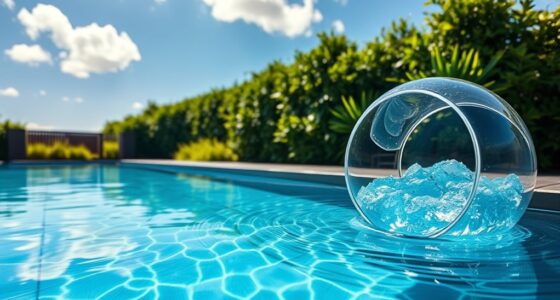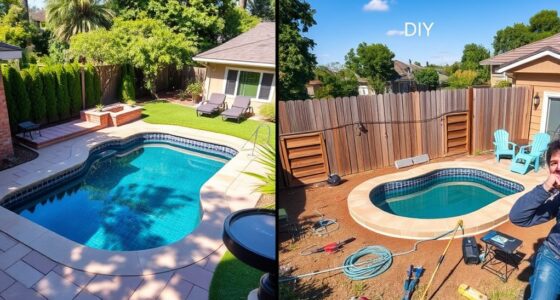When comparing the cost of ownership between an endless pool and a traditional pool, you’ll find endless pools are typically more budget-friendly upfront due to their smaller size and easier installation. They also cost less to maintain and operate, thanks to energy efficiency and fewer repairs. Traditional pools, however, usually require higher initial investments and ongoing expenses for chemical, repairs, and energy. To understand which options suits your finances best, explore the detailed differences that follow.
Key Takeaways
- Endless Pools typically have lower initial setup costs due to smaller size and simpler installation compared to traditional pools.
- Maintenance for Endless Pools is generally less frequent and less costly, extending their lifespan to 20-30 years.
- Operational energy costs are usually lower for Endless Pools because of their smaller size and integrated heating systems.
- Custom features and unexpected repairs can increase total ownership costs for both pool types, but traditional pools often require more frequent repairs.
- Resale value depends on durability and maintenance; Endless Pools may retain value longer with proper upkeep, while traditional pools can depreciate faster.
Initial Purchase and Installation Costs

When considering the initial purchase and installation costs, it’s essential to understand that these upfront expenses can substantially impact your overall budget. Endless Pools tend to be more affordable initially because they require less space and simpler installation processes. You might find that these pools can be set up in a smaller area, reducing site preparation costs. Traditional pools, on the other hand, often involve higher expenses due to excavation, extensive construction, and more complex plumbing and electrical work. Additionally, Endless Pools usually come as prefabricated units, which can be easier and quicker to install. While the initial investment for an Endless Pool is generally lower, keep in mind that your specific choices and customization options might influence the total cost. To optimize your investment, consider the space requirements and how they align with your backyard setup.
Ongoing Maintenance Expenses

While initial costs are important, ongoing maintenance expenses can substantially affect the total cost of ownership over time. You’ll need to budget for regular upkeep to keep your pool in top shape. Endless pools generally require less maintenance, but you still must consider filter replacements, water treatment, and periodic cleaning. Traditional pools often demand more frequent and costly tasks like chemical balancing, skimming, and equipment servicing. Additionally, the contrast ratio of your pool’s lighting and features can impact energy consumption and maintenance needs. Managing these expenses regularly helps prevent bigger issues later, ultimately saving you money and ensuring your pool remains a safe, enjoyable space.
Energy Consumption and Operating Costs

Your energy efficiency ratings directly impact your ongoing costs, so understanding them helps you make smarter choices. Breaking down operating expenses reveals where your money goes, including energy use and maintenance needs. By comparing these factors, you can find ways to reduce energy consumption and lower overall ownership costs. Additionally, selecting energy-efficient equipment like prosumer espresso machines can significantly influence your long-term expenses.
Energy Efficiency Ratings
Have you ever wondered how energy efficiency ratings impact your overall costs? These ratings help you gauge how much energy a pool consumes and how it affects your bills. A higher efficiency rating means lower energy use, which translates to reduced operating expenses. When comparing an Endless Pool to a traditional pool, look for models with advanced insulation, efficient pumps, and smart controls. These features optimize energy use and can save you money over time. Additionally, understanding AI security vulnerabilities can help ensure your smart pool systems remain protected from potential cyber threats.
Operating Cost Breakdown
Understanding the specific energy consumption of your pool is key to managing overall operating costs. Endless Pools are designed to be energy-efficient, reducing power use compared to traditional pools. They typically use less energy because of their smaller size and integrated heating systems, which are optimized for efficiency. Traditional pools, on the other hand, often require more energy for larger pumps, heaters, and filtration systems, leading to higher monthly costs. Your operating costs depend on factors like pool size, usage frequency, and energy rates. By monitoring your energy bills, you can identify how much each component contributes to your expenses. Keeping track of these costs helps you make informed decisions about operational adjustments, ultimately lowering your total ownership costs over time. Proper planning can also help you maximize efficiency and reduce unnecessary energy consumption.
Maintenance Energy Needs
Maintaining efficient energy use is essential to controlling ongoing operating costs for your pool. Both Endless Pools and traditional pools require energy for heating, circulation, and filtration, but their consumption varies. Endurance and design influence how much energy you’ll need to keep the water at a comfortable temperature and ensure proper circulation. To minimize costs, consider the following:
- Using energy-efficient pumps and heaters
- Installing programmable timers to operate during off-peak hours
- Improving pool insulation to reduce heat loss
- Regularly maintaining filters and equipment for peak performance
- Incorporating energy-saving techniques that optimize overall pool efficiency and reduce long-term expenses
Long-term Repairs and Upkeep

Long-term repairs and upkeep are crucial factors that can markedly influence the total cost of owning a pool. With an Endless Pool, you’ll generally face fewer major repairs because it has fewer moving parts and a compact design. Its durable components often require minimal replacement over time, reducing expenses. Traditional pools, however, can incur higher costs due to issues like cracked liners, damaged pumps, or corrosion of metal parts, which may need frequent repairs. Maintenance tasks such as replacing filters, addressing leaks, or fixing plumbing problems can add up. Regular upkeep helps prevent costly breakdowns, but the likelihood and expense of repairs tend to be lower with an Endless Pool. Additionally, the simple design of an Endless Pool makes routine maintenance less complicated and more cost-effective. Ultimately, understanding these long-term repair needs can help you make a more cost-effective choice.
Space and Installation Requirements

Have you contemplated how much space and the type of installation you’ll need for your pool? Endless pools are compact and can fit into smaller spaces, making them ideal for home gyms or basements. Traditional pools require a larger area, often outdoors, with more extensive setup. Here are key points to consider:
- Space requirements: Endurance pools fit in smaller areas, while traditional pools need significant yard space.
- Installation complexity: Endless pools are quick to install, often self-contained, whereas traditional pools involve extensive construction.
- Structural needs: Traditional pools may require significant site preparation and reinforced foundations.
- Permits and regulations: Larger pools often need more permits and adherence to local building codes.
- Material options: Self-watering plant pots come in various materials, including plastic, ceramic, and biodegradable options, which can influence installation and durability considerations.
Choosing the right option depends on your available space and installation preferences.
Resale Value and Longevity

When evaluating your pool options, considering how well it holds its value over time can influence your long-term investment. An Endless Pool typically retains its value better because of its compact size, energy efficiency, and modern design, appealing to future buyers looking for convenience. Traditional pools, especially those built-in and larger, may depreciate faster due to higher maintenance costs and the potential for structural wear. Longevity also plays a role; Endless Pools often last 20-30 years with proper care, thanks to durable materials and fewer parts exposed to the elements. In contrast, traditional pools may require more frequent repairs and upgrades, which can impact resale value. Ultimately, a well-maintained Endless Pool can be a smart investment that holds its worth longer over time. Additionally, understanding market trends can help you anticipate how your pool’s value may change with shifting consumer preferences.
Additional Features and Customization Costs

Adding extra features and customization options can substantially increase the overall cost of your pool. These upgrades often enhance comfort, convenience, and aesthetics, but they come with additional expenses. For example, you might consider:
- Advanced water filtration systems
- Custom lighting and sound setups
- Automated cleaning and maintenance devices
- Unique shapes or sizes tailored to your space
Each of these options adds to the initial investment and can lead to higher ongoing maintenance costs. While customization allows you to create a more personalized swimming environment, it’s essential to weigh the benefits against the added expenses. Carefully prioritize features that provide the most value for your lifestyle and budget to avoid overspending on unnecessary upgrades. Additionally, understanding metabolic changes and how they impact long-term costs can help you make informed decisions about your pool upgrades.
Budgeting for Unexpected Expenses

Unexpected expenses can catch you off guard, so it’s crucial to plan ahead. Maintenance costs often vary, and equipment may need replacing sooner than expected, adding surprise expenses to your budget. Setting aside emergency repair funds ensures you’re prepared for sudden issues without disrupting your finances.
Maintenance Cost Variability
Maintenance costs can vary considerably from year to year, making it essential to set aside a flexible budget. Unexpected expenses can arise suddenly, and being prepared helps prevent financial stress. For example, equipment malfunctions or pool component failures can lead to unplanned costs. Seasonal changes might also cause fluctuations in maintenance needs. To stay ahead, consider these potential cost drivers:
- Unexpected equipment repairs or replacements
- Sudden chemical balancing issues
- Unanticipated pool liner or surface repairs
- Seasonal maintenance spikes due to weather
Equipment Replacement Timing
Planning for equipment replacement is crucial because it helps you manage sudden expenses without disrupting your budget. Knowing when key components like filters, pumps, or heaters may need replacing allows you to set aside funds proactively. Endless pools tend to have integrated systems designed for durability, often requiring replacement every 10-15 years, depending on usage and maintenance. Traditional pools, with their separate equipment, might need replacements sooner or later, especially if neglected. By tracking equipment age and performance, you can anticipate upcoming costs and avoid surprise expenses. Regular inspections and manufacturer recommendations serve as guides for timing replacements. Creating a replacement schedule ensures your pool stays in prime condition without unexpected financial burdens, giving you peace of mind and better control over your overall pool ownership costs.
Emergency Repair Funds
Having a dedicated emergency repair fund is essential because equipment can fail suddenly, regardless of how well you’ve maintained your pool. Unexpected repairs can disrupt your swimming routine and lead to costly expenses. Preparing for these surprises guarantees you’re financially ready and minimizes stress. Consider setting aside a specific amount each month to cover unforeseen issues. Regularly monitor your pool’s condition so you catch problems early. Having this fund also helps avoid dipping into savings or taking on debt when emergencies arise. Keep in mind, unexpected repairs are inevitable with any pool type. By planning ahead, you stay protected against surprise expenses and keep your pool running smoothly.
- Cover major equipment failures
- Manage pipe leaks or cracks
- Handle filter or pump breakdowns
- Address electrical malfunctions
Frequently Asked Questions
How Does the Lifespan of an Endless Pool Compare to Traditional Pools?
Your Endless Pool typically lasts around 20 to 30 years with proper maintenance, comparable to traditional pools. Regular cleaning, equipment checks, and covering the pool when not in use help extend its lifespan. Unlike traditional pools that may face issues like liner replacement or extensive repairs, Endless Pools are designed for durability. With proper care, you can enjoy your investment for decades, making it a reliable, long-term addition to your home.
Are There Insurance Differences Between Owning an Endless Pool and a Traditional Pool?
You’ll find that insurance costs for an endless pool are often lower than traditional pools, mainly because they typically pose fewer risks. Since endless pools are compact and have fewer safety concerns, insurers view them as less hazardous. Additionally, their smaller size and modern design can lead to reduced premiums. So, if you’re considering ownership, expect potential savings on insurance, making endless pools a cost-effective choice overall.
What Are the Environmental Impacts of Each Pool Type Over Time?
You’ll find that traditional pools typically have a higher environmental impact over time due to their larger water and energy requirements for heating, filtering, and maintenance. Endless pools consume less water and energy since they’re smaller and often more energy-efficient. By choosing an endless pool, you reduce your carbon footprint and water usage, making it a more eco-friendly option for sustainable living.
Can an Endless Pool Be Easily Relocated or Dismantled?
Yes, an endless pool can be easily relocated or dismantled. Unlike traditional pools, its compact size and modular design make moving straightforward. You might worry about durability, but high-quality materials ensure it withstands disassembly and reassembly. With minimal tools and effort, you can enjoy flexibility, relocating your pool to a new spot or storing it away when not in use. This portability adds convenience and adaptability to your swimming setup.
How Do Warranty Options Typically Differ for Endless Pools and Traditional Pools?
Warranty options for endless pools often offer more exhaustive coverage, including parts, labor, and sometimes even setup assistance, because manufacturers see them as a specialized product. Traditional pools usually come with standard warranties that cover structural components and equipment but may have limited coverage on accessories or installation. You should review each warranty carefully to understand what’s included and consider extended warranties for added peace of mind.
Conclusion
When weighing the costs of an endless pool versus a traditional one, consider not just the price tag but the long-term expenses and benefits. Will investing in convenience, energy efficiency, and durability save you money and hassle down the line? Ultimately, choosing the right pool depends on your priorities and lifestyle. Are you ready to make a pool that fits your budget now and lasts for years to come?









